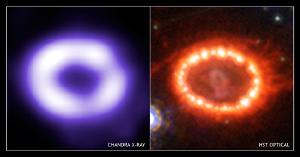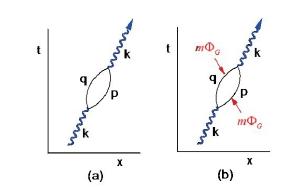Blog
Extraordinary Claims
28 June 2014
 X-ray: NASA/CXC/U.Colorado/S.Zhekov et al.; Optical: NASA/STScI/CfA/P.Challis
X-ray: NASA/CXC/U.Colorado/S.Zhekov et al.; Optical: NASA/STScI/CfA/P.ChallisA paper has recently been published in the New Journal of Physics claiming that the speed of light is wrong.1 This has triggered the usual headlines in the popular press, but as the saying goes, “extraordinary claims require extraordinary evidence.” So let’s look at the evidence behind this paper.
The motivation for the work comes from the 1987a supernova. This supernova appeared in the Large Magellanic Cloud, only 168,000 light years away. It was also the first (and only) time it was detected by neutrinos as well as electromagnetic light. About three hours before the supernova light reached Earth, neutrino spikes were observed at three separate neutrino observatories.
Now you might think it odd that the neutrinos were observed before the light. After all, nothing can travel faster than light (so it is claimed) so how is this possible? It turns out that neutrinos are not hindered by regular matter since they interact so weakly with it. Light, on the other hand, interacts strongly with matter. Light produced in the Sun’s core, for example, can take tens of thousands of years to reach the Sun’s surface due to all the material interactions. In a supernova the light and neutrinos are produced at the same time. The neutrinos pass almost immediately through the star, but the light is “trapped” in the star’s core until a shockwave starts to rip the star apart. At that point the density of stellar material is becomes low enough for the light to escape. Models calculate that this would occur about three hours after the initial reaction.
So the delay of light is due to the physics of a supernova, and not faster-than-light neutrinos. But it turns out that a couple hours before the three neutrino observatories detected the event, a fourth neutrino observatory observed a small spike of neutrinos. Since this spike wasn’t observed by the other neutrino detectors, it’s generally thought to be a random event. But the author argues that it is a valid detection from 1987a. Thus the initial reaction started earlier, and the light appeared a few hours later than models predict.
If you assume the first burst is valid, then there are a couple ways you could try to account for it. One is to look at the details of supernova models. You could argue, for example, that there is a double reaction where only the second reaction triggers a shock wave in the star. Thus you get two neutrino bursts, with a delayed appearance of light. The author of this paper decided to take a different route. He proposes that the first neutrino burst triggered the shock wave, and that the light was delayed because it was traveling slightly slower than we would expect. So based upon a single observation, the author decides to rewrite fundamental laws of physics.
So how do you get light to slow down? To do this, the author argues that over cosmic scales light can be affected by vacuum fluctuations within space. These fluctuations can produce “virtual” particles, and is a real effect in quantum mechanics. They can create things like the Casimir effect, and are thought to produce Hawking radiation in black holes. So the idea is that a photon traveling through space could split into an electron and positron for a tiny moment, then recombine into a photon.
 J D Franson
J D FransonThis has been looked at before, but the author takes a different view of the effect. Usually these virtual particles are not viewed as “real” in the traditional sense. This is because they are used as a part of a perturbative model where you have to add up all the the parts to get the correct answer. It’s kind of like adding up bunches of bananas. If you have a bunches of 6, 5, and 7, you would say you have 18 bananas total. You wouldn’t argue that physically first you have 6, then a moment later you have 11, then finally 18, even though you have counted them that way. The counting of the bananas doesn’t matter, just the final answer. Basically the author argues that the counting does physically matter. So the photon travels for a while, splits into an electron-positron pair for a fraction of a second, then combines back into a photon. While the photon is a particle pair it isn’t traveling at the speed of light, so over cosmic scales the travel time of light is slightly longer than expected. Running the calculations, the author gets the extra few hours needed to account for the first neutrino spike.
Most physicists argue that this method of dealing with vacuum fluctuations is completely wrong, but there is some debate about it on the fringes. The author of the paper does note at the end of the paper that this is a tentative model, but even so it has serious issues, such as the fact that the model violates conservation of energy. It seems to have been published as an exploration of an idea, which is fine. But it is hardly convincing as an argument that special and general relativity is wrong.
In the end it is an extraordinary claim with very little evidence to support it.
Franson, James D. “Apparent correction to the speed of light in a gravitational potential.” New Journal of Physics 16.6 (2014): 065008. ↩︎